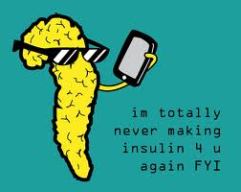No, it’s not a pager. But thanks for asking.
I have a contentious relationship with my pancreas. No, strike that — I have no relationship with my pancreas. When I was 18 it decided to jump ship and let me fend for myself. Two months later my thyroid ran off with it in some sort of twisted lover’s plot, leaving me confused and deathly ill, forced to adjust to life as an insulin-dependent diabetic with a thyroid condition. I handle my condition as nonchalantly as most people handle brushing their teeth, but it wasn’t always so. In my fifteen years as a diabetic I have encountered my fair share of people both professionally and personally who all profess to have my best interest at heart, who have tried to “help” me in their own way. How each of them define my best interest varies and often runs counter to my own definition. Well-intentioned as some of them may have been, I have experienced apathy, shaming, and blatant cruelty at the hands of such “concerned” individuals. The discourse between a patient and their support network can help or hinder that patient’s care and recovery, something I’ve experienced first-hand. Ethical communication within the health care field is a crucial part of patient care and its importance cannot be overemphasized, and the dialogue a patient has within themselves about their own illness helps sets the stage for ethical communication to take place.
(It’s so annoying when that happens. Photo credit pinterest.com)
Arnett, Fritz, and Bell (2009) discuss the idea of responsiveness in health care communication. Responsiveness refers to “ways to respond to the illness in the larger context of a life, not just for answers to ‘fix’ ill health” (p. 195). Ethical discourse between a patient and their support network relies upon this responsiveness. The responsiveness stems from what Arnett et al. (2009) refer to as the “why” and the “how” in a patient’s approach to their own care – in other words, when a patient has a “why”, a reason to care for themselves, they can bear any “how” in order to do so. I had this dialogic negotiation within myself as I learned to navigate a diabetic life. I was young and goal-oriented and had no desire to change my path. My attitude was, and has always been, how do I keep doing what I’m doing without becoming “a diabetic”? While I am not ashamed or ignorant of my condition, I don’t embrace it either. I don’t identify with it or center my life on it. As a result I rarely talk about it outside of a clinical setting. A care provider truly operating with my “best interest” in mind would honor my minimalist perspective, offering suggestion without judgment, and demonstrating respect for the challenges living with diabetes can bring. But all too often their definition of my “best interest” is to pore over numbers, analyze and calculate me to death, and attempt to “tell” me about my life from what they read in books. It’s frustrating at best, dehumanizing at worst.
(Yeah thanks for that. Photo credit schedule.sxsw.com)
As anybody who has undergone a similar transformation will tell you, adjusting to a diabetic lifestyle is not easy. The learning curve is enormous. You learn to test your blood sugar several times a day, then to inject insulin several times a day, and then a final transition to wearing an insulin pump. On top of all this you must learn to eat again, which is far more overwhelming than any of the medical training. Food becomes units of carbohydrates. Meals become calculated portions of nutrients. Eat this, not that, never these. Eating becomes a matter of survival, a mathematical equation. I remember staring into our pantry in those first few weeks and sobbing like somebody had died. I don’t know how to eat anymore.
(I wear one of these bad boys, a Minimed 722 Paradigm pump. Photo credit harmanlaw.com)
This all sounds rather intense and dramatic, and I suppose it was at the time. I have had a few emergencies that brought me to the ER but I am fortunate that I can count fifteen years’ worth on one hand. I consider myself fortunate that I had the luxury of a normal childhood, never having to forgo my Halloween candy for diabetic-approved ‘treats’ (which are never very good). I’m not going to wax poetic about all of the life lessons I’ve learned from my condition because frankly I find it embarrassing when people do that. It goes without saying that my paradigm has shifted and that I’ve learned to do things a little differently, but again, I choose to honor my life and my path apart from the diabetes. It’s like a buzzing fly that occasionally lands.
As a diabetic, my communication experiences in the health care field had a fabulous beginning. The diabetes management clinic that first treated me set the bar high enough that most have paled in comparison. Larry was my first diabetic educator. She was relatively young, sweet, and spoke uncomfortable truths with a kind voice. She was insulin dependent herself and had learned to draw up her own insulin injections when she was only four. She approached her diabetes with a casual pragmatism, combining the serious with the mundane. Larry had a level of understanding that surpassed any other professional I’ve worked with precisely because she knew what it was like to live as a diabetic. She understood, and her words reflected that. She modeled what Baker-Ohler (as cited by Arnett, Fritz, and Bell, 2009, p. 200) termed “labor of care” – a combination of labor, work, and action that embodied the human element of caregiving at its finest. Larry was sensitive to my needs, I was open to her knowledge, and we were able to engage in a successful ethical communication dialogue.
(Photo credit bmhvt.org)
Most other providers I’ve encountered since were polite but clinical. Write everything down, calculate when and what kind of exercise you’ll do and adjust your insulin and food intake accordingly. Half of this, plus two, carry the nine, and four ounces of orange juice at precisely this time o’clock. Report back to us with your food diary and your blood sugar log so we can pick it apart, look for patterns, and scold you for eating that piece of birthday cake. And by the way, how are you feeling? While done with good intention, my life, my outlook, was an afterthought. I was a set of lab results and not much else.
The darkest end of the spectrum came with a high-risk OBGYN during my third pregnancy. All of my pregnancies were high risk but this one was particularly awful – a toxic combination of intense stressors elsewhere in my life made it especially difficult to control my blood sugar. High blood sugar during a pregnancy can negatively impact fetal development, and every crazy blood sugar I had wracked me with guilt and fear. Toward the end of my pregnancy I saw a provider that was not my usual OB. This man declined to check my chart, inquire about my endocrinologist’s findings, or attempt to understand my situation. He asked me about my blood sugar readings in passing and immediately scoffed at my answers. He lectured me condescendingly for a few minutes, looked at my huge belly, and declared, “I’m surprised you haven’t killed that baby yet.” He concluded his visit and I sobbed all the way home, utterly dumbfounded that a physician could have said something so hateful to his own patient.
(Photo credit angels-and-you.blogspot.com)
Arnett, Fritz, and Bell (2009) mention the role energy plays in communication. “Human beings find the reason to respond from many sources, each giving a sense of energy” (p. 202). This doctor oozed disdain, apathy, and disinterest from the moment he walked into the exam room. Arnett et al. (2009) argue that “it takes the engagement of the labor of care to admit illness and then to take proper action” (p. 201). If this doctor was truly interested in my well-being and that of my child, he should have made an effort to engage in ethical communication with me – to display a combination of labor, work, and action that demonstrated what he felt was in my best interest (in this case, to control my blood sugars). Once that door was open, I could respond in kind by expressing my efforts and challenges. Unfortunately he declined to open that door. I’m sure he spends much of his life closed off from many things, including himself, but I hope for the sake of other patients that he makes an effort to open the door in the future.
Arnett, R.C., Fritz, J.M.H., and Bell, L.M. (2009). Communication ethics literacy: Dialogue and difference. Thousand Oaks, CA: SAGE Publications.
Posted on April 18, 2014, in COMM 616. Bookmark the permalink. Leave a comment.





Leave a comment
Comments 0